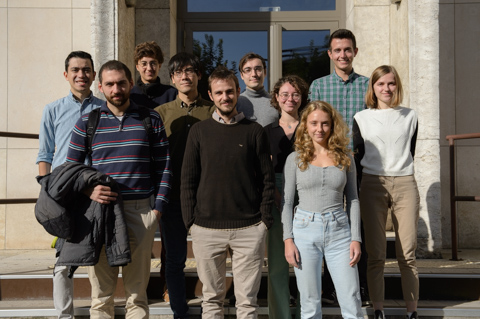
Photo: J. Mouette (IAP-CNRS-SU)
WELCOME TO THE CLASS OF 2022!
The new class of PhD students, post-doctoral fellows and engineer has joined the IAP in the fall of 2022.
During the welcome meeting that was held on October 6th 2022, the organization of the institute was presented to the new class, as well as the information they might need and the people they may contact during their stay in the laboratory.
The diversity of the subjects that will be addressed by these young researchers and engineer is large. Representative of this fact, their work at the IAP is funded by many sources: ministerial scholarships (including specific contracts for students from the Ecole Normale Supérieure), a scholarship from the DIM ORIGINES of the Île-de-France region, a “Physique des Infinis” Initiative (IPI) scholarship, a Tremplin fellowship, and an Emergence fellowship from Sorbonne Université, a scholarship from the Commissariat à l’énergie atomique et aux énergies alternatives (CEA), a scholarship from the Centre National d'Etudes Spatiales (CNES), a scholarship and a fellowship from the Agence Nationale de la Recherche (ANR) and from the European Research Council (ERC), fellowships from the Simmons Foundation (for more information, see Partnerships). The entire staff of the IAP wishes them a fruitful stay, and many rich scientific and technical exchanges.
The laboratory also congratulates the new doctors, who recently left the Institute at the end of their theses.
| Iryna Chemerynska | “Constraining feedback in low-mass galaxies with James Webb Space Telescope (JWST) observations” |
| Marion Guelfand | “Unveiling cosmic-ray mysteries through radio: modeling and analysis of radio signals detected with GRAND” |
| Léonard Lehoucq | “Compact binaries and their host galaxies” |
| Alice Maurel | “Cloudy super-Earths and rocky planets” |
| Louise Paquereau | “Unveiling the galaxy-dark matter connection in the early Universe with the James Webb Space Telescope (JWST)” |
| Lou Roussel-Hard | “Multidimensional radiation hydrodynamics for supernovae” |
| Grégoire Aufort | “What triggers dramatic changes in galaxy star-formation histories? An analysis on the Euclid DEEP fields” |
| Deaglan Bartlett | “Inference of cosmological parameters with the `Bayesian Origin Reconstruction from Galaxies' (BORG) software” |
| Pierre Boldrini | “Optimal transport applied to cosmology” |
| Barnabàs Deme | “Kinetic theory of stellar systems” |
| Amélie Gressier | “Modeling and observations of hot exoplanet atmospheres, from super-Earths to mini-Neptunes” |
| Matthew Ho | “Information content of large scale structures and of the cosmic microwave background (CMB)” |
| Ali Rida Khalife | “Constraining alternatives to the Lambda-Cold Dark Matter model with the new SPT-3G receiver for the 10-meter South Pole Telescope (SPT)” |
| Kunyang Li | “Massive black hole dynamics” |
| Shohei Saga | “Vlasov-Poisson equations” |
| Sophie Huot | “Software development for the Euclid mission” |
Layout and iconography: Jean Mouette
October 2022
